To install door locks, first, measure the distance between the edge of the door and the center of the doorknob hole. Then, drill a hole in this location to accommodate the lock mechanism, and attach the lock to the door with screws.
Choosing The Right Door Locks
Factors to consider when selecting door locks
Choosing the right door locks is an essential step in ensuring the security of your home. With the wide variety of options available in the market, it can be overwhelming to make a decision. However, there are several factors to consider that can help you select the perfect door lock for your needs.
- Type of property: Consider the type of property you have. Is it a residential or commercial property? The type of property can influence the level of security you require. Commercial properties may require more advanced and sophisticated locks compared to residential properties.
- Security level: Assess the security needs of your property. Are you looking for a basic lock for residential purposes or do you need a high-security lock for added protection? Determine the level of security required to make an informed choice.
- Door material: Take into account the material of your door. Different door materials may require specific types of locks for optimal functionality and security. For example, wooden doors may be better suited for mortise locks, while metal doors may require deadbolt locks.
- Budget: Set a budget for your door locks. Determine how much you are willing to spend on your security measures. Keep in mind that investing in a high-quality lock is a long-term investment in your safety and peace of mind.
- Brand reputation: Research and choose reputable brands when selecting door locks. Trusted brands often offer reliable products that have undergone rigorous testing to ensure durability and security.
- Installation process: Consider the ease of installation when selecting door locks. Some locks may require professional installation, while others can be easily installed by homeowners. Determine whether you prefer a DIY installation or if you would rather hire a professional.
- Compatibility: Ensure that the door lock you choose is compatible with your existing door and hardware. Taking measurements and understanding the specifications can help you avoid costly mistakes and ensure a proper fit.
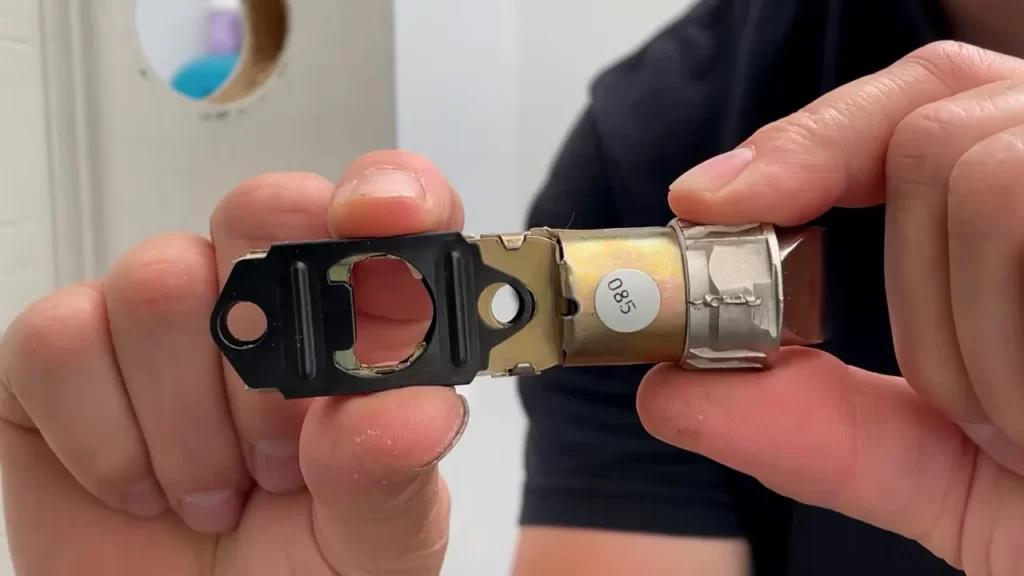
Different types of door locks available in the market
When it comes to door locks, there are various options available in the market. Each type offers its unique features and advantages. Understanding the different types of door locks can help you make an informed decision.
| Type of Door Lock | Description |
|---|---|
| Deadbolt locks | These locks provide a high level of security due to their sturdy construction. They are available in single-cylinder and double-cylinder options. |
| Mortise locks | These locks are more complex and require a pocket or mortise to be cut into the door. They offer excellent security and are often used in commercial properties. |
| Knob locks | These locks are commonly found on residential doors. While they offer some basic security, they are not as durable as deadbolt locks and should be supplemented with additional security measures. |
| Lever handle locks | These locks are designed for ease of use and accessibility, making them a popular choice for commercial properties that require compliance with accessibility standards. |
| Keyless entry locks | These locks use alternative methods of authentication, such as keypads or biometric scanners, offering convenience and eliminating the need for physical keys. |
By considering the factors mentioned and understanding the different types of door locks available, you can confidently choose the right door lock to enhance the security of your property.
Types Of Door Locks
When it comes to home security, one of the most critical elements is installing proper door locks. Depending on the level of security you desire, there are various types of door locks available that you can choose from. In this post, we will take a closer look at three popular types of door locks: deadbolts, knob locks, and lever handle locks.
Deadbolts
Deadbolts are considered one of the most secure types of door locks available. These locks are typically installed on exterior doors and provide an extra layer of security. Unlike spring-bolt locks, deadbolts do not have a spring mechanism and require manual operation to lock and unlock. This makes them more resistant to forceful entry attempts.
There are two main types of deadbolt locks:
| Single Cylinder Deadbolt | Double Cylinder Deadbolt |
|---|---|
| A single cylinder deadbolt is the most common type of deadbolt lock. It uses a key cylinder on the exterior side and a thumbturn on the interior side. | A double cylinder deadbolt requires a key to lock or unlock the door from both the interior and exterior sides. This type of deadbolt provides an increased level of security, but it also means that a key is always required to exit the property. |
Knob locks
Knob locks are commonly found on interior doors, such as bedroom or bathroom doors. While they provide a basic level of security, they are not recommended for use as the primary lock on exterior doors. Knob locks are vulnerable to forced entry due to their design, which makes them easier to manipulate or break.
Lever handle locks
Lever handle locks are another popular choice for both residential and commercial properties. They are easier to operate, especially for individuals with limited hand mobility, compared to knob locks. Lever handle locks are commonly used in offices, schools, and healthcare facilities. However, it’s important to note that lever handle locks may be more susceptible to picking or forced entry compared to deadbolt locks.
When installing door locks, it’s crucial to carefully consider the level of security you desire for each entry point in your home. Choosing the appropriate type of door lock can significantly enhance the safety of your property and protect your loved ones and belongings.
Preparing For Installation
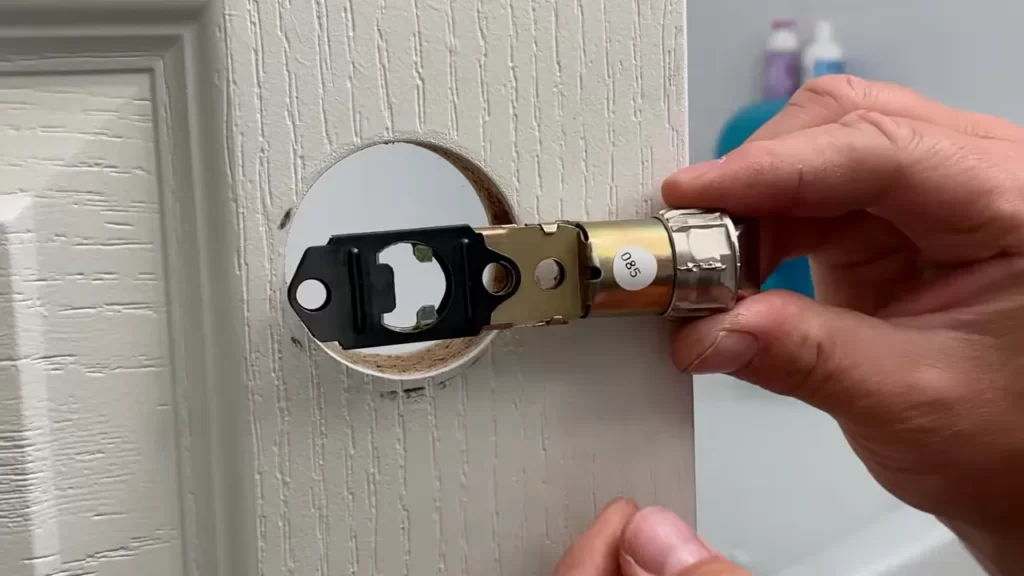
Before you can can install a new door lock, it’s important to take the necessary steps to prepare. This will ensure a smooth and successful installation process. In this section, we’ll cover two key steps: gathering the necessary tools and materials, and measuring and marking the door for the lock.
Gathering the necessary tools and materials
Before you begin installing a door lock, make sure you have all the necessary tools and materials at hand. This will save you from unnecessary trips to the hardware store during the installation process. Here is a list of what you will need:
| Tools | Materials |
|---|---|
| Screwdriver (flathead or Phillips, depending on lock)DrillChiselTape measure | New door lockLocksetScrewsStrike plateLatchWood putty |
Having these tools and materials ready and within reach will ensure a smooth installation process.
Measuring and marking the door for the lock
Once you have gathered all the necessary tools and materials, the next step is to measure and mark the door for the lock. This step is crucial to ensure that the lock is installed in the right position and functions properly. To measure and mark the door, follow these steps:
- Start by measuring the backset, which is the distance from the edge of the door to the center of the lock borehole. Most standard door locks have a backset of either 2 3/8 inches or 2 3/4 inches. Use a tape measure to accurately measure the backset.
- Using a pencil, mark the centerline of the backset on the edge of the door. This will serve as a guide for positioning the lock.
- Measure the height of the lockset, which is the distance from the center of the lock borehole to the top or bottom of the door. Mark the height on the edge of the door using a pencil.
- Next, mark the position of the latch plate on the edge of the door. The latch plate is usually located about 6 inches above the bottom of the door. Use a tape measure to accurately measure and mark the position of the latch plate.
- Finally, mark the position of the strike plate on the door jamb. The strike plate is aligned with the latch plate and is positioned so that the latch bolt can properly engage with it. Use a pencil to mark the position of the strike plate.
By following these measurements and markings, you will ensure that the door lock is installed correctly and functions smoothly.
Installing A Deadbolt Lock
One of the most effective ways to secure your home is by installing a deadbolt lock. A deadbolt lock adds an extra layer of protection, making it much harder for intruders to break in. If you’re new to home improvement projects, don’t worry. Installing a deadbolt lock is a straightforward process that you can easily do yourself. In this guide, we’ll walk you through the step-by-step process of removing the existing door hardware, drilling holes for the deadbolt lock components, and installing the deadbolt lock and strike plate.
Removing the existing door hardware
The first step in installing a deadbolt lock is to remove the existing door hardware. This typically includes the doorknob and the latch plate. Follow these simple steps to safely remove the old hardware:
- Begin by unscrewing the screws on the doorknob with a screwdriver. Once the screws are loose, you can easily remove the knob.
- Next, look for the screws on the latch plate (the piece that attaches to the door jamb). Remove these screws as well.
- Once the screws are removed, you should be able to pull out the latch plate and remove it from the door jamb.
Drilling holes for the deadbolt lock components
With the existing door hardware removed, it’s time to drill the necessary holes for the deadbolt lock components. Here’s how you can do it:
- Using a tape measure, mark the centerline of the door edge where the deadbolt lock will be installed.
- Measure the backset, which is the distance from the edge of the door to the center of the doorknob hole.
- Using the appropriate drill bit size for your deadbolt lock, drill a hole on the centerline and at the appropriate backset measurement.
- Drill another hole on the face of the door where the latch will go.
Installing the deadbolt lock and strike plate
Now that the holes are drilled, you’re ready to install the deadbolt lock and strike plate. Follow these steps:
- Insert the deadbolt lock into the hole on the edge of the door, ensuring that the bolt extends in and out smoothly.
- Screw the lock cylinder into place on the interior side of the door.
- Place the strike plate on the door jamb, ensuring that it aligns perfectly with the deadbolt lock.
- Making sure the deadbolt lock is properly aligned, mark the position of the strike plate screw holes on the jamb.
- Remove the strike plate and drill pilot holes for the screws.
- Finally, install the strike plate by screwing it into the door jamb, securing it tightly.
With the deadbolt lock and strike plate installed, your door is now safely secured. Remember to test the lock multiple times to ensure smooth operation. By following these simple steps, you can successfully install a deadbolt lock and provide extra security to your home.
Installing A Knob Lock
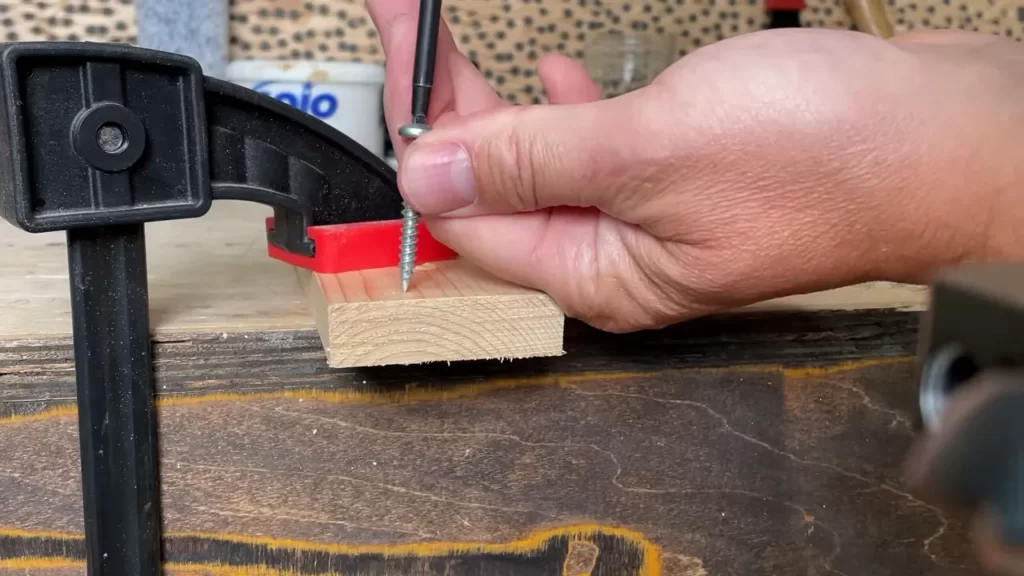
Installing a knob lock is a simple yet crucial step in securing your home. A knob lock is often used in conjunction with deadbolts for enhanced security. In this guide, we will walk you through the process of installing a knob lock on your door, from removing the existing door hardware to drilling holes for the knob lock components, and finally, installing the knob lock and strike plate.
Removing the existing door hardware
The first step in installing a knob lock is to remove the existing door hardware. This includes the old knob, latch, and strike plate. Use a screwdriver to unscrew and remove all the screws holding the hardware in place. Once the screws are removed, gently pull out the knob and latch. Set aside the old hardware for disposal or reuse.
Drilling holes for the knob lock components
With the existing door hardware out of the way, it’s time to prepare the door for the installation of the knob lock. The knob lock consists of two main components: the knob itself and the latch. The latch is the mechanism that engages with the strike plate to keep the door securely closed.
To install the knob lock, you’ll need to drill two holes in the door. The first hole is for the knob, and the second hole is for the latch. Measure the appropriate distances from the edge of the door using the instructions provided with your knob lock. Mark the locations of the holes with a pencil, ensuring they are aligned and level.
Now, get your drill ready with the appropriate drill bit size as specified in the instructions. Carefully drill the first hole, making sure to maintain a steady hand and apply consistent pressure. Once the first hole is drilled, move on to the second hole following the same procedure. Keep in mind that the depth of the second hole may vary depending on the specific knob lock you are installing.
Installing the knob lock and strike plate
After drilling the required holes, it’s time to install the knob lock and strike plate. Begin by inserting the latch into the hole on the edge of the door. Ensure it is fully inserted and aligned correctly. Secure the latch in place using the screws provided with your knob lock.
Next, take the knob itself and align it with the hole on the outside of the door. Insert the knob and connect it with the latch mechanism on the inside of the door. Once the knob is securely in place, attach it to the door using the screws provided.
Finally, install the strike plate on the door jamb. Line it up with the latch and secure it in place using screws. Ensure that the strike plate is properly aligned with the latch so that the door can close and open smoothly.
That’s it! You have successfully installed a knob lock on your door. Remember to test the lock to ensure it is functioning properly before fully relying on it for security. With your new knob lock in place, you can have peace of mind knowing that your home is safer and more secure.
Troubleshooting Common Issues
Door misalignment
One common issue you might encounter when installing a door lock is door misalignment. This can prevent the lock from functioning properly and can make it difficult to secure your door. If you notice that your door is not aligned properly, there are a few steps you can take to troubleshoot and fix the problem.
Here’s what you can try:
- Check for any obstructions or debris: Sometimes, dirt, dust, or debris can accumulate in the door frame, causing a misalignment. Use a brush or vacuum cleaner to remove any obstructions.
- Tighten the door hinges: Loose or worn-out door hinges can also contribute to a misalignment. Inspect the hinges and tighten any loose screws. If the hinges are damaged, consider replacing them.
- Adjust the strike plate: The strike plate is the metal plate attached to the door frame that the lock bolt enters when the door is locked. If the strike plate is misaligned, the lock may not latch properly. Loosen the screws holding the strike plate in place and carefully adjust its position until the door locks smoothly.
- Check for warped doors: If none of the above solutions work, your door may be warped. Warped doors can be challenging to fix, and you may need to consult a professional to repair or replace the door.
Difficulty in turning the key
If you’re having difficulty turning the key in your newly installed door lock, there are several potential causes and solutions to consider.
Here’s what you can do:
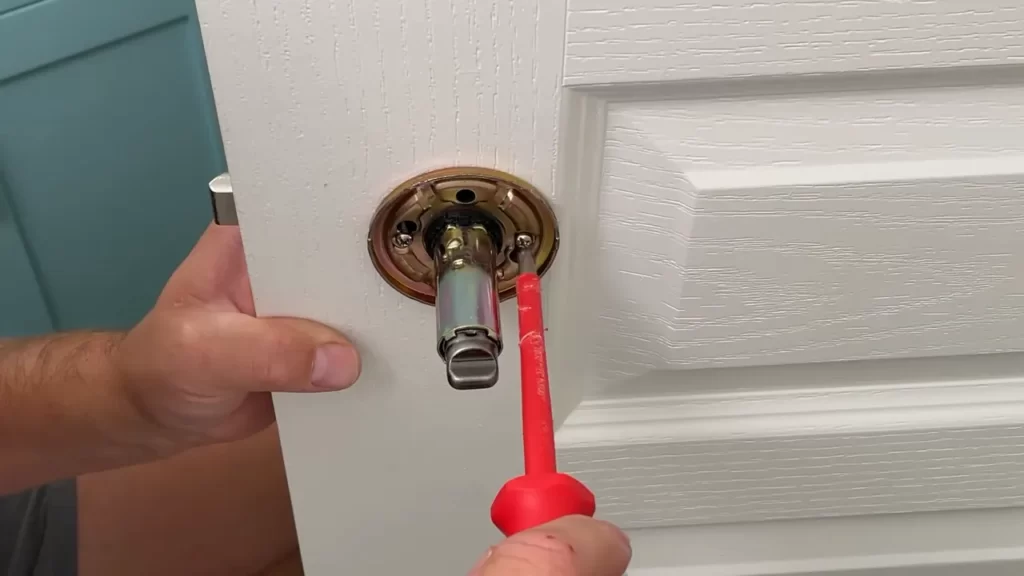
- Check for key obstruction: Before assuming there’s an issue with the lock, inspect the key for any visible obstructions or damage. Clean the key and remove any debris before attempting to turn it.
- Lubricate the lock: Over time, locks can become dry and stiff, making it difficult to turn the key. Apply a small amount of graphite lubricant or lock lubricant to the key and insert it into the lock. Gently wiggle the key back and forth to distribute the lubricant.
- Check for alignment issues: Misalignment can also cause difficulty in turning the key. Refer to the troubleshooting steps mentioned earlier for door misalignment and follow those steps to fix any alignment issues.
- Consider a professional evaluation: If the key still doesn’t turn smoothly after attempting the above solutions, it may be best to contact a locksmith or professional door lock installer for further evaluation and possible repairs.
Loose or wobbly lock
A loose or wobbly lock not only compromises the security of your door but also indicates an installation problem. Fortunately, there are steps you can take to address this issue and ensure your lock is securely attached to the door.
Follow these steps:
- Tighten the lock screws: One possibility is that the screws securing the lockset to the door have come loose. Use a screwdriver to tighten all the screws on the lockset, including those on the faceplate, strike plate, latch, and latch plate.
- Replace worn-out screws: If the screws are stripped or damaged, they may not provide a secure hold. Replace any worn-out screws with new ones of the appropriate size and type.
- Check for proper strike plate installation: The strike plate should be securely attached to the door frame with screws that penetrate the frame’s stud or the structural framing of the wall. Ensure that the strike plate is installed correctly and adjust as needed.
By troubleshooting these common issues, you can ensure that your newly installed door lock functions smoothly, providing you with the security and peace of mind you need.
Installing A Lever Handle Lock
Removing the existing door hardware
The first step in installing a lever handle lock is to remove the existing door hardware. This includes the doorknob or lever handle, latch plate, and strike plate. Follow these steps:
- Close the door and locate the screws holding the doorknob or lever handle in place.
- Using a screwdriver, remove the screws and carefully detach the doorknob or lever handle from the door.
- Next, locate the screws that secure the latch plate on the edge of the door. Remove these screws and slide out the latch plate.
- Finally, locate and remove the screws securing the strike plate on the door frame. Take note of the size and position of the strike plate for proper installation later.
Drilling holes for the lever handle lock components
Once the existing door hardware has been removed, it’s time to prepare the door for the lever handle lock components. Follow these steps:
- Using a tape measure and pencil, mark the desired height for the lever handle on the door. Typically, this is around 36 inches from the bottom of the door for residential applications.
- Measure and mark the position of the latch plate on the door edge. The latch plate should align with the center of the lever handle.
- With the measurements in place, use a hole saw to drill a hole for the lever handle spindle on the face of the door. Ensure the hole saw size matches the specifications of the lever handle.
- Next, use a drill and bits to create holes for the latch plate and strike plate. Refer to the manufacturer’s instructions for the correct hole sizes.
Installing the lever handle lock and strike plate
Now that the necessary holes have been drilled, you can proceed with the installation of the lever handle lock and strike plate. Follow these steps:
- Insert the lever handle spindle into the hole on the door’s face. Ensure it aligns properly and the handle can move freely.
- Position the latch plate on the door edge and secure it with screws. Make sure the latch faces the correct direction and extends smoothly.
- Line up the strike plate with the hole in the door frame and secure it with screws. Ensure it aligns perfectly with the latch and allows the door to close and latch securely.
- Test the lever handle lock by opening and closing the door.
- If everything functions properly, tighten all screws and make any necessary adjustments for smooth operation.
By following these steps, you can successfully install a lever handle lock on your door. Enjoy the enhanced security and convenience it provides!
Tips For Proper Door Lock Installation
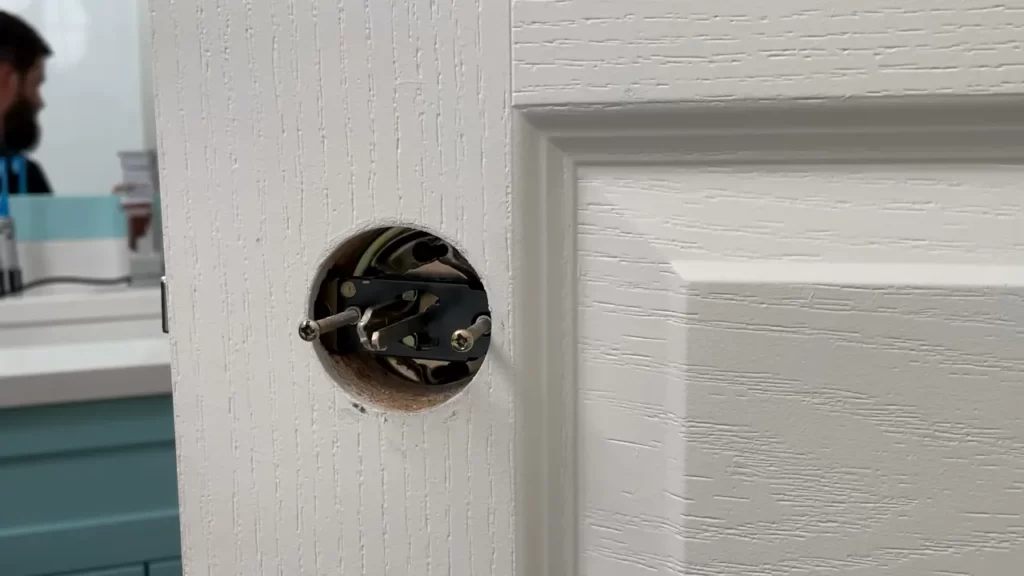
Properly installing door locks is essential for the security and functionality of your doors. Whether you are replacing an old lock or installing a new one, there are a few tips to keep in mind to ensure a smooth and secure installation process. In this article, we will cover two important tips that you should follow while installing door locks: Ensuring the lock aligns properly with the door frame and Checking if the lock operates smoothly. Let’s dive into the details.
Ensuring the lock aligns properly with the door frame
Proper alignment of the door lock with the door frame is crucial for the lock to function effectively. Here are a few steps to follow to ensure that your lock aligns properly:
- Start by determining the ideal height for your lock. This can vary based on personal preference and accessibility requirements. Typically, the recommended height for a lock is around 36 inches from the bottom of the door, but you may adjust it as needed.
- Next, mark the spot where the lock will be installed on the door edge. Use a ruler or measuring tape to ensure accurate placement.
- Ensure that the hole for the lockset aligns perfectly with the latch position on the door jamb. Use a template provided with the lockset to mark the position and make the necessary preparations for drilling.
- With the help of a drill, carefully create the necessary holes for the lockset. Take your time and double-check the measurements to avoid any mistakes.
- Once the holes are made, test the alignment by attaching the lockset to the door and inserting the latch into the door jamb. The lock should fit smoothly without any resistance or misalignment.
- If you notice any alignment issues, make the necessary adjustments by enlarging or repositioning the holes until the lock fits perfectly into the door frame.
Checking if the lock operates smoothly
After ensuring proper alignment, it is crucial to check if the lock operates smoothly. Here’s what you should do:
- Insert the key into the lock and try turning it clockwise and counterclockwise to ensure smooth operation. The key should turn effortlessly without any sticking or resistance.
- Test the lock’s deadbolt or latch mechanism by closing the door and attempting to lock it. The lock should engage easily and securely without any wiggling or loose movements.
- If you encounter any issues, such as sticking or grinding sensations while operating the lock, consider applying lubrication to the moving parts. This can help alleviate friction and improve the lock’s performance.
- Remember to test the lock multiple times to ensure consistent and reliable operation.
Following these simple yet important tips will help you install door locks properly, ensuring both security and convenience. By aligning the lock correctly with the door frame and checking its smooth operation, you can enhance the overall functioning of your door locks and provide peace of mind for yourself and your loved ones.
Maintaining Door Locks For Longevity
Lubricating the lock regularly
One of the key aspects of maintaining door locks for longevity is regular lubrication. Over time, dirt, dust, and debris can accumulate in the lock mechanism, causing it to become stiff and difficult to operate. To prevent this, it is important to lubricate the lock regularly.
When lubricating the lock, it is essential to use a lubricant specifically designed for locks. Avoid using WD-40 or other general-purpose lubricants, as they can attract more dust and debris, ultimately causing more harm than good.
To lubricate the lock, follow these simple steps:
- Insert the key into the lock and turn it to the unlocked position.
- Apply a small amount of lock lubricant to the key.
- Insert the key into the lock and slowly turn it back and forth several times to distribute the lubricant throughout the mechanism.
- Wipe off any excess lubricant with a clean cloth.
By lubricating the lock regularly, you can ensure smooth operation and extend the lifespan of the lock.
Inspecting and replacing worn-out components as needed
Another important aspect of maintaining door locks for longevity is regular inspection and replacement of worn-out components. Over time, the various components of a door lock, such as springs, tumblers, and pins, can become worn or damaged, leading to a decrease in functionality and security.
To keep your door lock in optimal condition, it is crucial to inspect these components on a regular basis. Here’s how you can do it:
- Remove the lock from the door.
- Check for any signs of wear or damage on the springs, tumblers, and pins.
- If any components appear worn or damaged, it is important to replace them promptly.
- Consult the lock manufacturer’s instructions or seek professional help if you are uncertain about the replacement process.
By inspecting and replacing worn-out components as needed, you can maintain the functionality and security of your door lock, ensuring its longevity.
Frequently Asked Questions On How To Install Door Locks
Can You Install A Door Lock Yourself?
Yes, you can install a door lock yourself. It’s a simple DIY task that doesn’t require professional assistance. Just follow the instructions provided with the lock and use basic tools like a screwdriver. Save time and money by doing it yourself.
How Do You Install A Door Lock Without Drilling?
To install a door lock without drilling, opt for adhesive or magnetic locks. These locks can be easily attached to the door surface using adhesive or magnets, eliminating the need for drilling holes. Ensure the door surface is clean and dry before applying the lock for better adhesion.
It’s a convenient and drill-free solution for securing your doors.
How Much Does It Cost To Install A Door Lock?
Door lock installation costs vary depending on the type of lock. On average, it can range from $75 to $200 for a basic lock installation. Specialized locks or additional services may cost more.
How Do You Install A Door Latch Lock?
To install a door latch lock, follow these steps: 1. Begin by placing the latch plate on the door edge. 2. Mark the screw holes and drill pilot holes. 3. Secure the latch plate with screws. 4. Next, insert the latch mechanism into the door frame.
5. Test the lock and adjust as necessary before tightening the screws.
How Do I Choose The Right Door Lock For My Home?
When selecting a door lock, consider the level of security needed, the type of door, and your budget.
What Tools Do I Need To Install A Door Lock?
You will need a tape measure, screwdriver, chisel, drill, pilot bit, and a door lock installation kit.
Conclusion
Installing door locks can be a simple yet important step in enhancing the security of your home or office. By following the step-by-step instructions provided in this guide, you can easily install door locks and ensure the safety of your premises.
Remember to choose the right type of lock for your needs and to take the necessary measurements before starting the installation process. With consistent practice and adherence to safety guidelines, you’ll gain the confidence to handle any door lock installation like a pro.
